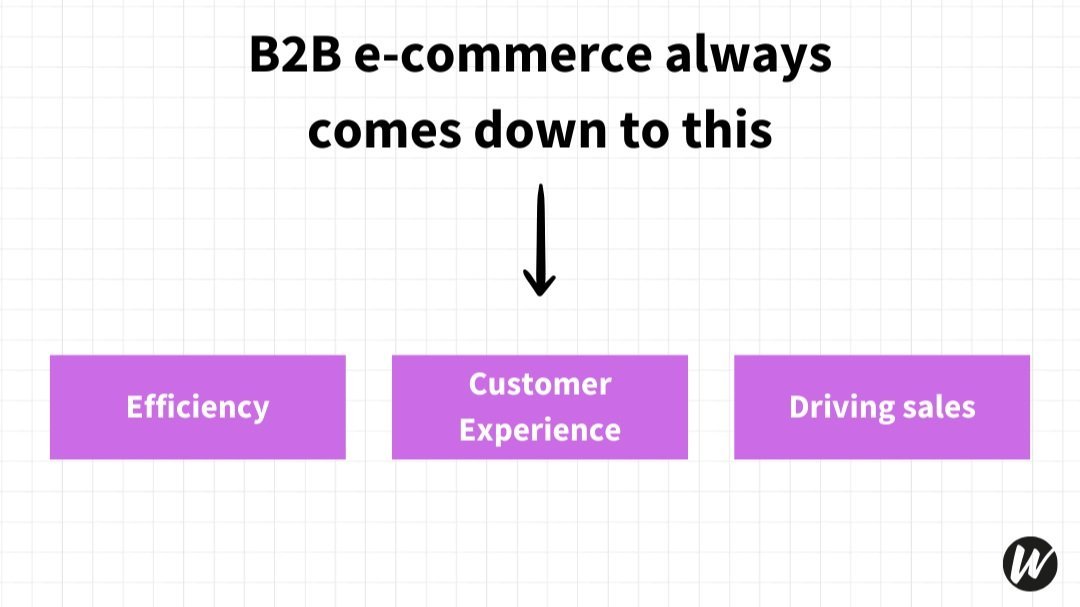The are only three reasons for doing customer portals and B2B e-commerce
There are three reasons for engaging in B2B e-commerce. After more than a decade in this field, it always boils down to these three reasons.
The priority of these reasons varies depending on the agenda.
🚀 Efficiency
In organizations, massive amounts of time, effort, and employees are consumed by manual, repetitive tasks such as:
Receiving orders via email and entering them into the ERP system.
Emailing back and forth with customers about stock levels.
Requesting quotes and receiving responses.
Requesting documentation and statistics on currently installed products.
B2B e-commerce and customer portals are excellent ways to eliminate such inefficiencies. These tools allow customers to view valuable information and place orders directly in a portal without contacting customer service.
Efficiency is sometimes labelled as “cost saving,” which is essentially another side of the same coin.
In many B2C businesses, especially retail, manual operations have already been eliminated. In the fashion industry, every time a product is handled, it incurs a cost—whether it’s hanging it on the rack, rehanging after a customer tries it on, or marking it down for sale. This mindset is crucial in B2B contexts as well. Every manual interaction with a customer or order incurs costs, such as:
Emailing customers about delayed orders.
Assigning orders to different warehouses.
Notifying customers about a replacement for a spare part.
All these costs could be eliminated, thereby creating a more efficient operation.
🌟 Customer Experience
A digital customer interface not only drives better efficiency within an organization but is also increasingly demanded by customers. Research indicates that a staggering 60-80% of B2B customers start their journey online. Customers desire digital interactions and 24/7 access to information.
For instance, one customer, after a pilot of a new portal, stated: “When I place an order online instead of emailing customer service, it takes 1-2 days less to receive the package.” Initially, I did not understand what the customer meant since the online solution used the same order-fulfilment process as email orders—same DHL/UPS trucks, same factory cut-off times, etc. Upon clarification, the customer explained: “Usually, we email back and forth with customer service before the order is actually placed. And that ping-pong takes 1-2 days.” So, from the customer’s perspective, the total time from considering an order to receiving it was shorter.
Many companies claim that digital interactions are not suitable for their industry. While not all digital interactions are appropriate for every industry—such as setting strategic frame agreements or collaborative product development—many can be digitized, and even if not fully, partially.
Even with a highly customized built-to-order product, consider incorporating:
A Price-Configure-Quote functionality instead of a traditional webshop.
Selling spare parts or consumables online.
Offering customer support via chat.
Providing access to data and documentation.
Handling claims and warranty requests.
There is always something that can be improved digitally.
📈 Increase Sales
The prospect of increasing sales beyond current customers is compelling. Who does not want to sell more?
Overall, there are three ways to drive increased sales:
Increase sales among existing customers.
Attract new customers or qualified leads in existing markets.
Enter new markets, which could be geographical or new segments.
Increasing sales among existing customers is a common approach. Methods to achieve this include upselling, cross-selling, promoting assortments, and campaigns. The native traits of online business—giving digital access to assortment information and lowering the threshold to place an order—also drive increased sales. For example, one industrial company that rolled out an extensive B2B e-commerce initiative saw existing customers order new products from the assortment that had been available for 10 years, simply because they were not aware of them.
Another distributor noted that the average order value of online orders was higher than those placed via customer support, even though the price, lead time, and offered assortment were the same. Customers tended to add extra items to their basket when placing online orders.
Attracting new customers or qualified leads in existing markets is facilitated by making the customer journey visible online, which increases the opportunity to be seen. Combined with effective marketing, this can attract new customers. It’s crucial to expose as much of the customer journey online as possible rather than hiding it behind a login. Dare to show information, prices, and lead times—details usually reserved for existing customers. If you offer customizable products that require a quote process, consider allowing customers to place a quote request online and use a configuration solution to build their product.
Entering new markets: A customer portal or B2B e-commerce platform allows you to enter new markets without having to scale all other operations significantly. Of course, one must still consider many other factors when entering a new market, such as legal requirements and logistics.
One manufacturer, with an online price configure and quote solution and an automated backend process, managed to go live in new markets without increasing the operations in quote reception and processing. Instead of hiring ten new people for a region, they hired one.
Author: Helena Strahl, Consultant and partner at Waye. She has long experience of working with B2B e-commerce.

